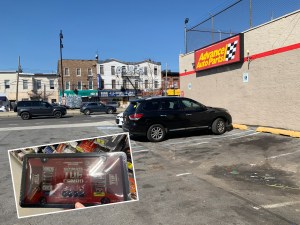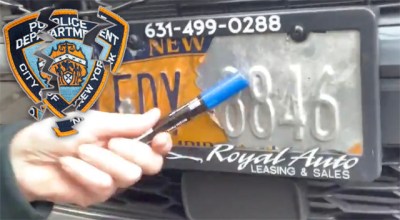Data: Unreadable Plates Soared Last Year, Foiling Speed and Red-Light Cameras

It’s an even bigger cover up.
The problem of cars evading speed, red-light and bus-lane cameras with defaced or covered plates has gotten markedly worse — with more than 7 percent of plates that triggered automated enforcement cameras last summer proving to be unreadable.
According to new data obtained by Streetsblog from the city Department of Transportation, the portion of unreadable plates peaked in August 2022 — the month when speed cameras were expanded to a 24-7-365 system — with the city unable to read 7.38 percent of the plates on cars triggering enforcement cameras.
Exactly one year earlier, that figure was 4.72 percent — which itself was up from just 1.26 percent in August 2019.
The new data, complete through 2022, builds on earlier stats presented last year by The City that were complete through December 2021, when just 3.98 percent of plates were deemed unreadable. By December 2022, 4.66 percent of plates were unreadable:
A second chart using the same data (below) shows just how much money the city is possibly losing from the unreadable plates (see methodology below):
As a result of unreadable plates — which can result from a car bearing temporary plates, no plates, or defaced or covered plates — the city has lost as much as $38.7 million in unissued tickets since January 2019. At the peak of unreadable plates in August 2022, the city lost as much as $3.3 million that month alone.
Meanwhile, the MTA, which operates tolls on multiple city bridges, says its counts of unreadable plates is far lower than New York City’s: In 2022, the agency claims only 0.9 percent of plates were unreadable due to fraudulent or obstructed license plates. (But then, the MTA’s gantries scan for E-Z Pass, and only need to read the plate in the absence of an E-Z Pass device. Many drivers pay MTA tolls, but obscure their plates to avoid city enforcement cameras.)

It’s not completely clear why the city’s cameras were failing last year to capture an increasing number of plates or even what caused the citywide spike, but some developments speak for themselves:
- The percentage of unreadable plates started rising in 2020 when the number of speed cameras started rising, perhaps causing more drivers to want to avoid the growing number of eyes in the sky.
- The rise in unreadable plates also coincides with the beginning of the Covid-19 pandemic, which caused many states to close their departments of motor vehicles, which led to a well-documented surge in fraudulent temporary tags.
- An additional spike in unreadable plates occurred in 2022, when the city’s speed-camera program expanded into a 24-7-365 system, up from just daytime hours on weekdays, providing more incentive for scofflaw drivers to find ways to evade tolls.
The August 2020 spike came just days after Mayor Adams announced a crackdown on fake temporary tags. And unreadable and covered plates continued to rise even after promised crackdowns in the previous administration.
The Department of Transportation said it has difficulty connecting temporary tags to a registered car owner, most likely because many temporary tags are fraudulently issued. The agency says it is looking at ways to better track temporary tags, but declined to offer specifics.
Agency spokesman Vin Barone said that the automated camera program is a success that can’t be erased by the single-digit percentage of drivers who evade cameras.
“Our automated enforcement programs save lives by changing driver behavior — in fact, after we turned on speed cameras 24 hours a day in August, speed declined significantly, by 25 percent,” he said (see chart).
The DOT also frequently points out that the agency has spent $1.7 billion in capital and expense funds on its Vision Zero effort since 2014 — three times more than the speed camera program brought in in revenue.

But unreadable plates are not only a revenue loser for the city general fund — they’re also a safety issue. Several high-profile fatal crashes, including Isaiah Benloss in Brooklyn in 2021, 5-year-old Jonathan Martinez in Queens in September 2022, and Walter Gonzalez one month later in Brooklyn, were caused by drivers operating vehicles with untraceable plates.
So many defaced plates — do I have enough time (and ink) to commit CRIMINAL MISCHIEF everywhere? Well, the effort continues in Crown Heights. pic.twitter.com/Ymp5kqiWfm
— Gersh Kuntzman (@GershKuntzman) December 12, 2022
“The drivers of these [ghost] cars are up to no good,” Mayor Adams said last year. “The law is coming after anyone who tries to make their car untraceable. We will not allow vehicles to be weaponized and our streets to be turned into a battlefield.”
Street safety advocates also focused not on the revenue implications, but on the road violence ramifications.
“Drivers who use illegal or fake license plates to avoid accountability make streets more dangerous for all New Yorkers. Our city and state leaders must investigate and put an end to the rise of illegal plates that also steal revenue from critical government programs,” said Danny Harris, the executive director of Transportation Alternatives.
Methodology
To calculate the maximum amount of ticket revenue the city is missing out on, we did the following:
- Obtained the total number of camera-issued tickets issued in every month from public data.
- Multiplied that by the number of plates that DOT told us were unreadable. The resulting number is the maximum number of additional tickets that could have been written.
- Multiplied by $50, which is the cost of camera-issued tickets (minus any fees).





